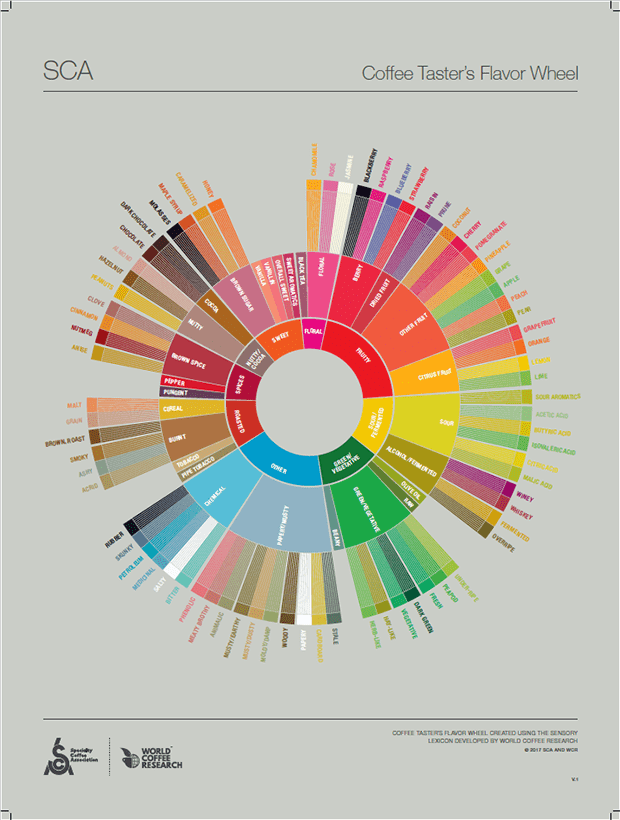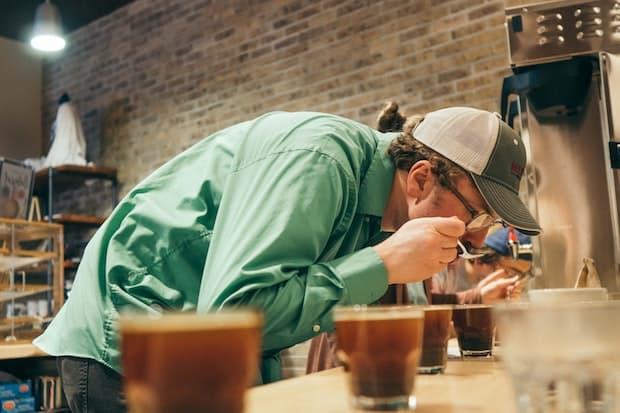Last Updated on December 13, 2023
With this column, Bean Poet welcomes new contributor Dr. Molly Spencer, who worked closely with the Specialty Coffee Association to redesign the Coffee Taster’s Flavor Wheel as part of her Ph.D. studies in Food Science at UC Davis.
Whether you’re a coffee novice or a coffee expert, chances are that you have had at least one bad cup of coffee before. You have probably also enjoyed many delicious cups of coffee.
But what makes a cup of coffee good or bad?
Coffee preferences vary from person to person, but it is the sensory qualities of your brew that determine whether you like it, especially the flavor. That is why coffee brands strive to consistently deliver flavor profiles (tasting notes) that their consumers will enjoy. In order to do this, the prominent flavors must be identified in a descriptive, replicable manner. This is where the Coffee Taster’s Flavor Wheel comes in.
Reinventing the coffee Flavor Wheel
The original Coffee Taster’s Flavor Wheel was published in 1995 by Ted Lingle for the Specialty Coffee Association (SCA) to aid the coffee industry in describing coffee flavor. However, it was biased in two ways:
- It was designed in a non-scientific manner from just one person’s experiences.
- It was presented as two separate flavor wheels – one for desirable flavors and the other for undesirable flavors.
This is inherently biased because flavor preferences are not universal. A flavor that is desirable to one consumer may be undesirable to another consumer.
By 2015, many advances had been made in coffee research and sensory science, and this called for a redesigned flavor wheel, generated using scientific methods. SCA, World Coffee Research (WCR), three universities, and dozens of coffee professionals contributed to this effort.
The Lexicon
First, the WCR Sensory Lexicon was developed at the Sensory Analysis Center in Kansas State University. Sensory experts tasted a vast array of coffee samples and identified 110 aroma, flavor, and texture attributes to describe coffee, known as descriptors.
Each descriptor has a specific definition and at least one sensory reference. This is to align the coffee industry on the sensory language used to describe the flavors inherently present in coffee. For example, the lexicon definition of hazelnut is “a woody, brown, sweet, musty/earthy, slightly cedar aromatic. May include floral, beany, oily, astringent, and bitter flavor notes.” The corresponding flavor reference for hazelnut is McCormick Imitation Hazelnut Extract, in milk, with preparation instructions of different concentrations to achieve differing intensities. This is to anchor lexicon users with a clear definition as well as concrete sensory experiences assigned to the descriptor.
The Flavor Wheel
As a graduate student, I worked with SCA to generate the redesigned flavor wheel, which is essentially an organized visualization of the WCR Sensory Lexicon. To do this, we had 72 sensory and coffee experts complete a sorting task of the 99 flavor attributes (descriptors). We analyzed the results to determine the categories (the first tier), sub-categories (second tier), and location of the attributes on the wheel.

Similar flavors are in the same category and are close to one another on the flavor wheel. Flavors that are less similar are found on opposite sides of the wheel. For example, the sub-category Citrus Fruit appears between the related subcategories Sour and Other Fruit, but opposite from unrelated sub-categories such as Papery/Musty and Burnt.
Additionally, the color of each descriptor is intended to be a representation of that flavor – for example, Lime is lime-green and Lemon is lemon-yellow. This resulted in an array of colors displayed around the wheel.
Using the Flavor Wheel
The redesigned Coffee Taster’s Flavor Wheel was published in 2016, and along with the WCR Sensory Lexicon, it has been used as a valuable resource and communication tool to unify the sensory language used in the coffee industry. It was the largest, most collaborative research effort in the coffee industry to date, the product of a combined effort by WCR, SCA, and dozens of sensory scientists and coffee professionals. Both the lexicon and flavor wheel are living documents, meaning they can be updated to add, modify, or remove flavors.
It was a truly special experience to be a part of this research, and for that I am grateful. It was an opportunity that created more unique opportunities for me as a graduate student at the beginning of my career: visits to coffee farms in Nicaragua and Taiwan, an academic paper, several overly caffeinated conference presentations and flavor wheel workshops, and numerous connections to wonderful, friendly people in the coffee industry.
In the future, as more coffee research is completed, the hope is to be able to predict how processing changes at any step of the coffee supply chain will affect the final flavor in your cup. For example:
- What flavors are present in a light roast versus dark roast of the same beans?
- How does the brewing method you choose affect the flavor of your coffee?
- How does the origin of your coffee beans impact the flavor?
These types of questions can only be answered if we can describe coffee flavor consistently, which is why the WCR Sensory Lexicon and the Coffee Taster’s Flavor Wheel are so valuable to both the coffee industry and interested coffee drinkers at home.
References
- World Coffee Research Sensory Lexicon: https://worldcoffeeresearch.org/work/sensory-lexicon/
- “Using Single Free Sorting and Multivariate Exploratory Methods to Design a New Coffee Taster’s Flavor Wheel,” Journal of Food Science: https://onlinelibrary.wiley.com/doi/full/10.1111/1750-3841.13555


